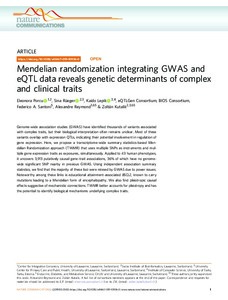Mendelian randomization integrating GWAS and eQTL data reveals genetic determinants of complex and clinical traits
Eleonora Porcu; Sina Rüeger; Kaido Lepik; eQTLGen Consortium; BIOS Consortium; Federico A. Santoni; Alexandre Reymond; Zoltán Kutalik
Mendelian randomization integrating GWAS and eQTL data reveals genetic determinants of complex and clinical traits
Eleonora Porcu
Sina Rüeger
Kaido Lepik
eQTLGen Consortium
BIOS Consortium
Federico A. Santoni
Alexandre Reymond
Zoltán Kutalik
NATURE PUBLISHING GROUP
Julkaisun pysyvä osoite on:
https://urn.fi/URN:NBN:fi-fe2021042823941
https://urn.fi/URN:NBN:fi-fe2021042823941
Tiivistelmä
Genome-wide association studies (GWAS) have identified thousands of variants associated with complex traits, but their biological interpretation often remains unclear. Most of these variants overlap with expression QTLs, indicating their potential involvement in regulation of gene expression. Here, we propose a transcriptome-wide summary statistics-based Mendelian Randomization approach (TWMR) that uses multiple SNPs as instruments and multiple gene expression traits as exposures, simultaneously. Applied to 43 human phenotypes, it uncovers 3,913 putatively causal gene-trait associations, 36% of which have no genome-wide significant SNP nearby in previous GWAS. Using independent association summary statistics, we find that the majority of these loci were missed by GWAS due to power issues. Noteworthy among these links is educational attainment-associated BSCL2, known to carry mutations leading to a Mendelian form of encephalopathy. We also find pleiotropic causal effects suggestive of mechanistic connections. TWMR better accounts for pleiotropy and has the potential to identify biological mechanisms underlying complex traits.
Kokoelmat
- Rinnakkaistallenteet [27094]
